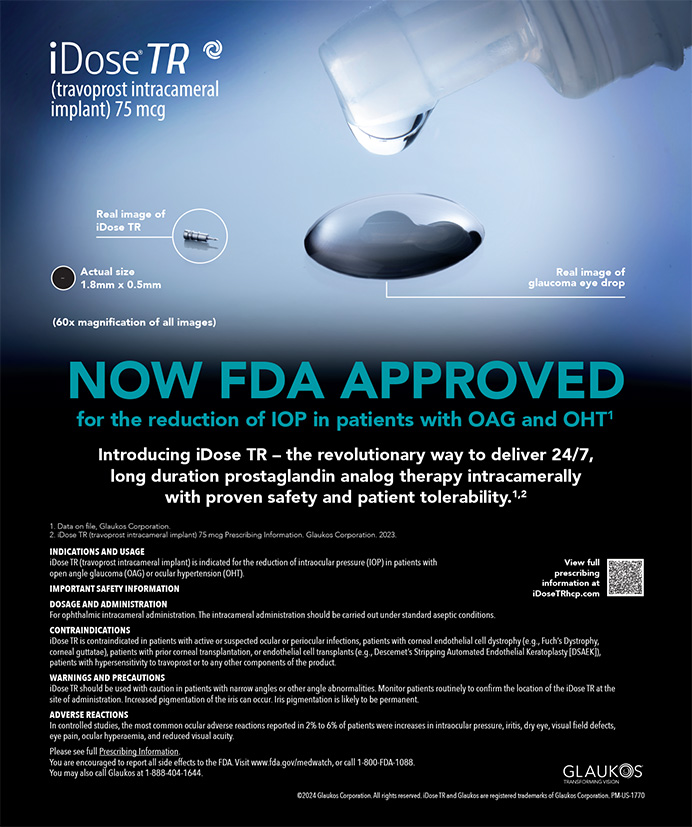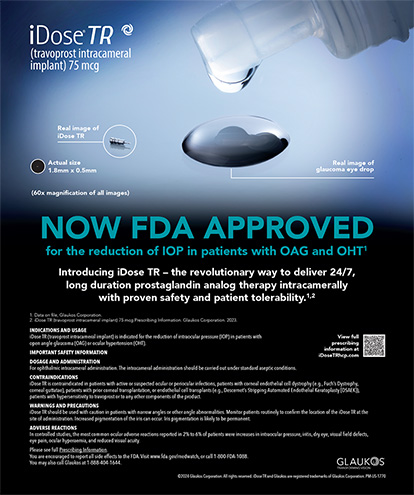In our corneal and external disease practice, my colleagues and I see many patients with dry eye disease. Although a patient's signs and symptoms often make the diagnosis straightforward, in many cases, we rely on a series of tests. Most ophthalmologists are familiar with analyses upon which we have relied for many years, such as tear film breakup time, Schirmer testing, and conjunctival and corneal staining. The downside of these tests is that their results are mainly subjective and not easily quantifiable. In addition, they are not particularly effective at monitoring the efficacy of therapeutic treatments.
Corneal disease experts have known for many years that testing tear osmolarity—the measurement of the salinity level in tears—is an effective and objective assessment for dry eye disease.1 Previously, this testing was only available in large reference laboratories and required a fairly large volume of tears. A new tear osmolarity testing system, called the TearLab Osmolarity System (TearLab Corp., San Diego, CA), is eliminating these challenges. The TearLab Osmolarity System uses a minute volume of tears (50 nL) to measure the salinity level and provides the ophthalmologist with a quantifiable, real number that indicates the presence and/or absence and severity of the dry eye.
HOW IT WORKS
The TearLab's technology uses a novel approach that concentrates laboratory functions on a single chip that requires less than 50 nL of tear fluid in order to measure tear osmolarity. The system uses a handheld pen on which the ophthalmologist or technician places the noninvasive laboratory chip test card. After he collects the tear sample (usually in less than 30 seconds), the device produces the measurement of osmolarity in less than 1 minute.
Studies have shown that, not only is osmolarity testing objective and quantitative, it is a highly specific biomarker. In dry eye disease, the accuracy of tear film osmolarity is considered superior to any other single measurement for dry eye analysis, including Schirmer testing and corneal staining.1,2
CLINICAL EXPERIENCE
My colleagues and I recently started a multicenter clinical study that will compare the results we obtain with TearLab to those we have received with the traditional means of dry eye diagnosis. Our initial impression is that the TearLab system works very well in patients with dry eye. All tested subjects show an increase in osmolarity, and these findings have correlated with those from traditional testing methods.
We have found the TearLab to be quite user friendly; it does not require an ophthalmologist to apply it. Our patients have also found the test to be comfortable and have indicated their preference for it over the Schirmer test.
IMPACT ON DIAGNOSIS AND MANAGEMENT
For diagnosis, the initial unpublished data from our multicenter study show that the TearLab system works and that there is a correlation between dry eye and the osmolarity value (Table 1). This should also mean that that the system can differentiate between healthy corneas and dry eyes.
Managing dry eye is as equally important as diagnosing it and can also benefit from an objective test. Just as we should be able to see a corresponding decrease in osmolarity levels when we administer artificial tears that have properties of hyposmolarity, we intend to study such cause and effect with the TearLab system. We expect the objective TearLab Osmolarity System to give us a better mechanism for tailoring treatments to the individual patient based on his osmolarity measurements—providing us with a much more effective way to manage dry eye.
Jose M. Benitez-del-Castillo MD, PhD, is a professor of ophthalmology at the University Complutense, and director of the Ocular Surface Unit at Clinica Ruber, Madrid, Spain. He has received research funding from TearLab Corp. Dr. Benitez-del-Castillo may be reached at +34 902875204; benitezcastillo@terra.es.
- Tomlinson A, Khanal S, Ramaesh K, et al. Tear film osmolarity: determination of a referent for dry eye diagnosis. Invest Ophthalmol Vis Sci. 2006;47:4309-4315
- Dry Eye Workshop (DEWS) Committee. 2007 Report of the Dry Eye Workshop (DEWS). Ocul Surf. 2007;5(2):65-204.


